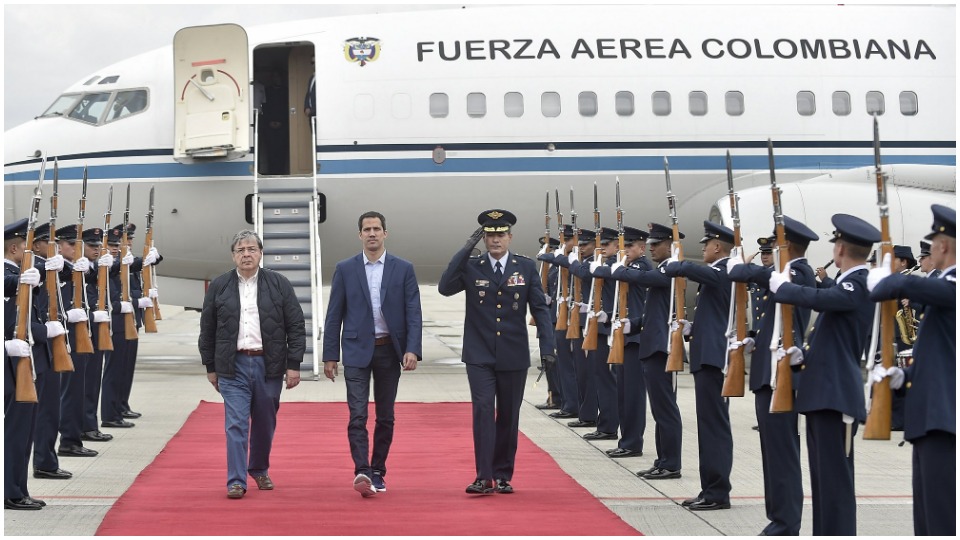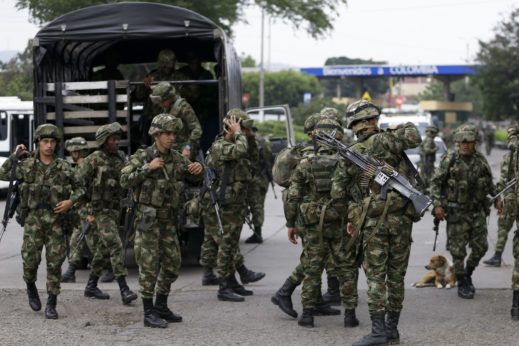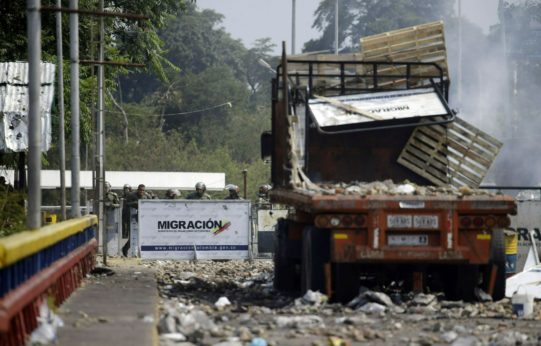
On February 23, the U.S. and Colombian governments joined in trying to push humanitarian supplies from the Colombian border city Cúcuta into Venezuela. They were using humanitarian aid as a Trojan Horse to confront Venezuelan security forces. These were supposed to have stepped aside, Venezuela’s military forces would, in theory, have disintegrated, and a take-down of its socialist government would follow. But the soldiers, police, and people’s militia remained loyal to the emancipating legacy of President Hugo Chávez. They blocked the trucks and the façade shattered.
Fire consumed a truck heading for the border. The rubble contained aid material but also whistles, gas masks, steel cables, spikes, and wires. Anti-government rioters in Venezuelan streets would go without.
Colombia is a U.S. proxy warrior. It’s a partnership prepared over the course of decades, is dangerous for the neighborhood, and is central to U.S. pretensions in the region. An understanding of why the alliance is strong and how it persists may shed light on the context of the Cúcuta incident and on what’s to come.

The flow of money is one aspect. According to a U.S. Department of Commerce report, “the United States is Colombia’s largest trading partner” and “U.S. exports to Colombia in 2017 [were] valued at USD 13.3 billion.” U.S. direct investment of $2.2 billion exceeded that of all other countries in 2017. The U.S. ultra-rich have soul mates in Colombia. Millionaires there numbered 21,900 in 2007, 35,900 in 2012. One percent of Colombians own 40.65 percent of the wealth there. Colombia’s income inequality is one of the highest in the world—second only to that of the United States.
What solidifies the alliance seems to be: one, ideological solidarity manifesting as anti-communism and, two, Colombia’s perceived reliability in advancing conservative goals. In fact, Colombia’s ruling class stops at nothing to stay in power.
President Alfonso López Pumarejo’s government did advance liberal reforms in the 1930s. Otherwise, big landowners always and business moguls recently have controlled Colombian politics. Low points since World War II were the proto-fascist President Laureano Gómez, military dictator Gustavo Rojas, oligarchic conservative and liberal presidents, and ultra right-winger Alvaro Uribe. The latter’s protégée Iván Duque is president now.
Colombia’s army murdered some 2,000 striking banana workers in Ciénaga on December 5-6, 1928. Jorge Eliécer Gaitán, a hero to aroused Colombian masses, was murdered April 9, 1948, under strange circumstances. From 1986 on, dark forces murdered 5,000 members of the Patriotic Union electoral coalition, mostly Communists. Since 2016, assassins have taken 431 lives of activists, including labor leaders and community organizers.
The targeting of leftists has been standard fare in the United States, but without the blood. Resurrecting the Red Scare, President Trump recently in Miami delivered a diatribe hitting at Venezuela and socialism.
In a show of anti-communist collaboration, the United States brought 20 Latin American nations to Bogota in 1948 to set up the Organization of American States. They took the pledge to fight communism. Colombian Alberto Lleras Camargo, a future president, was the first OAS secretary-general. Colombian troops joined U.S. forces in the Korean War, alone among their Latin American peers.
Colombia’s government battled the Marxist-oriented FARC insurgency from 1964 until 2016.The U.S. government supplied its partner with military equipment, personnel, and advice—and, between 2001 and 2016 with $10 billion. Civilians and combatants killed in the war totaled 220,000. But the United States remained aloof from peace initiatives of the last decades of the conflict. Its military settled into seven Colombian bases.
The Colombian government has implemented only bits and pieces of the peace agreement ending the conflict. Prominent FARC peace negotiator Jesus Santrich, wrongly imprisoned, faces extradition to the United States. Fearing the same, head FARC negotiator Iván Márquez is on the lam. Over 500 former insurgents, captured as prisoners of war, remain imprisoned. The money faucet is still open: “U.S. government agencies have poured nearly three-quarters of a billion dollars into Colombia since 2017,” reports Tracey Eaton.
In both countries, abuse and neglect ravage the underclass, and campaigns for social justice frighten reactionaries imbued with anti-communism. Yet upper echelons in the United States may even take reassurance from social ills in Colombia. They may well argue that resistance there is ineffectual only because of being suppressed. They value the suppressors as reliable allies because they are good at what they do.

Social distress is indeed overflowing. In La Guajira, a Colombian state bordering Venezuela, 5,000 Wayúu Indian children died of starvation during the past 10 years. Over 58 percent of the people live in poverty, 25 percent of them in extreme poverty. Buenaventura is a seaport on the Pacific coast and a profit center. People there are 90 percent African-descended and 80 percent poverty-stricken (41 percent live in extreme poverty). Some 71 percent have limited access to water; 40 percent, no access to sewage; and 65 percent, no jobs.
“In Cúcuta, with 750,000 people,” as historian Renán Vega Cantor observes, “40 percent of the people can’t pay basic expenses; 70 percent work in the informal sector; 25.3 percent have no access to drinkable water. The poverty rate is 40 percent … and the income for one percent of the population derives from illegal sales of contraband goods from Venezuela.”
Ironies abound. On February 23, Venezuelan President Nicolás Maduro broke diplomatic relations with Colombia. Simon Bolívar, the inspiration for Venezuela’s Bolivarian Revolution, in 1819-1830 headed the nation called “Gran Colombia.” Today’s Colombia and Venezuela were part of it. It had a constitution, the “Constitution of Cúcuta.”
Almost 200 years ago, Bolívar proclaimed that the United States was “destined by Providence to plague America with misery in the name of liberty.” Soon, Karl Marx would identify capitalism as the truly responsible party.










